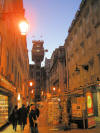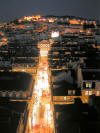|
BAIRRO ALTO AND
ELEVADOR DE SANTA JUSTA
The Bairro Alto (Upper Quarter) occupies the top of a
steep hill just west of Lisbon's Baixa district.� This
area functions as a residential, shopping, and entertainment
district.� Up in this area you will find great
nightlife and also a smattering of Lisbon's famous Fado houses,
which are a must-see experience in Portuguese culture.�
|
� |
�
 |
Fado is a Portuguese institution, much like the Flamenco in Spain.�
It is a singing performance in an old tavern, usually accompanied by
dinner.� The two performers are a man with a Portuguese guitar
and a lady in a black shawl, and each sings a story of sadness and
sorrow.
 |
Igreja do
Carmo church survived the 1755 earthquake without a roof |
 |
Elevador de Santa Justa |
 |
Looking south
towards the river from the Elevador |
 |
Nightfall at the Castel S�o Jorge |
Lisbon offers numerous ways to climb the steep hill to the Bairro
Alto (besides walking up stairs, of course).� There are
numerous elevadors (usually funicular trains) which take pedestrians
from the bottom of the hill to the top (or vice versa).�
The Elevador de Santa Justa (on Santa Justa street in the Baixa) is
the lone vertical transport.� This elevador was designed by
Raul Mesni�r de Ponsard, an apprentice of Gustave Eiffel, of Eiffel
Tower fame.� This 45 meter iron tower was built in 1902 and
connects the Baixa with the Bairro Alto's Carmo Square.�
The terrace at the top of the Elevador provides fantastic views over
the city.�
The map below identifies Lisbon's Bairro Alto district in red.
 |
Bairro
Alto |
 |
Alfama |
 |
Baixa |
 |
Elevador
de Santa Justa |
 |
This grid
of streets in Bairro Alto form the epicenter of Lisbon's
nightlife. Here you will find clubs, bars, and (of course)
numerous fado bars to suit your tastes |
 |
Rua Garret
is the place to go for cafes and boutique stores. |
View Larger Map
�
|